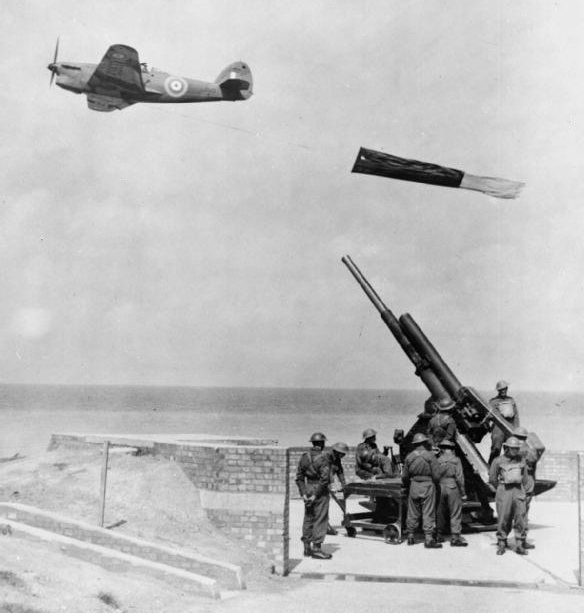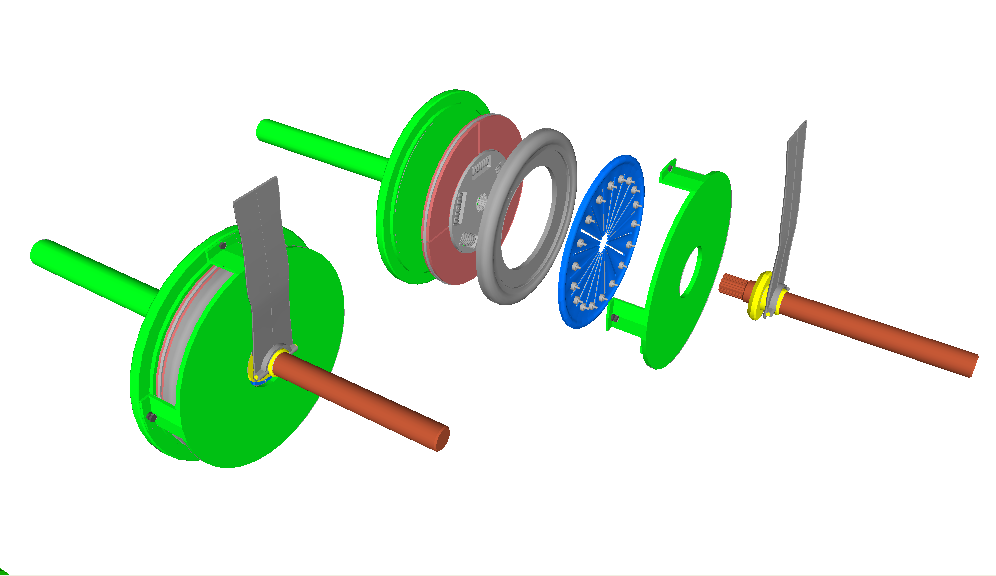|
Target Tug
A target tug is an aircraft which tows an unmanned drone, a fabric drogue or other kind of target, for the purposes of gun or missile target practice. Target tugs are often conversions of transport and utility aircraft, as well as obsolescent combat types. Some, such as the Miles Martinet, were specially designed for the role. Flying a target tug was, and is, a relatively hazardous job, as live fire is typically employed and the people doing the shooting are usually still in training. History World War 2 Prior to and during World War II target tugs were typically operated by the air arms on behalf of which they flew, and were usually conversions of aircraft that had failed in combat or that were otherwise unsuitable or obsolete in their design roles (see Fairey Battle and Short Sturgeon). These aircraft typically trailed a drogue fabric sleeve at the end of a several-thousand metre long cable. Student fighter pilots or air gunners would shoot at the target from other aircr ... [...More Info...] [...Related Items...] OR: [Wikipedia] [Google] [Baidu] |
Hawker Henley
The Hawker Henley was a British two-seat target tug derived from the Hawker Hurricane that was operated by the Royal Air Force during the Second World War. Design and development In 1934 Air Ministry Specification P.4/34 was issued which called for a light bomber that could also be deployed in a close-support role as a dive-bomber. Fairey, Gloster and Hawker each offered designs to fill this role. As the aircraft only required a modest bomb load and with performance paramount, Hawker developed an aircraft similar to their Hurricane fighter. The Hurricane was then in an advanced stage of development and there would be economies of scale if some assemblies were common to both aircraft. This resulted in the Henley sharing outer wing panels and tailplanes with the Hurricane. Both were equipped with the Rolls-Royce Merlin engine which offered the best power-weight ratio and minimized frontal area. The Henley's cantilever fabric-covered monoplane wing was mid-set, a retractable ... [...More Info...] [...Related Items...] OR: [Wikipedia] [Google] [Baidu] |
Douglas Skyraider
The Douglas A-1 Skyraider (formerly designated AD before the 1962 unification of Navy and Air Force designations) is an American single-seat attack aircraft in service from 1946 to the early 1980s, which served during the Korean War and Vietnam War. The Skyraider had an unusually long career, remaining in frontline service well into the Jet Age (when most piston-engine attack or fighter aircraft were replaced by jet aircraft); thus becoming known by some as an "anachronism". The aircraft was nicknamed "Spad", after the French World War I fighter. It was operated by the United States Navy (USN), the United States Marine Corps (USMC), and the United States Air Force (USAF), and also saw service with the British Royal Navy, the French Air Force, the Republic of Vietnam Air Force (RVNAF), and others. It remained in U.S. service until the early 1970s. Design and development The piston-engined, propeller-driven Skyraider was designed during World War II to meet United States Navy r ... [...More Info...] [...Related Items...] OR: [Wikipedia] [Google] [Baidu] |
Fairey Firefly
The Fairey Firefly is a Second World War-era carrier-borne fighter aircraft and anti-submarine aircraft that was principally operated by the Fleet Air Arm (FAA). It was developed and built by the British aircraft manufacturer Fairey Aviation Company. Development of the Firefly can be traced back to a pair of specifications issued by the British Air Ministry in 1938, calling for new naval fighter designs. Designed to the contemporary FAA concept of a two-seat fleet reconnaissance/fighter, the pilot and observer were positioned at separate stations. In flight, the Firefly was superior in terms of both performance and firepower to its predecessor, the Fairey Fulmar. Due to a protracted development, the type only entered operational service towards the end of the conflict, at which point it was no longer competitive as a fighter. The limitations of a single engine in a relatively heavy airframe reduced its performance, but the Firefly proved to be a fairly sturdy, long-ranged, an ... [...More Info...] [...Related Items...] OR: [Wikipedia] [Google] [Baidu] |
Hawker Sea Fury
The Hawker Sea Fury is a British fighter aircraft designed and manufactured by Hawker Aircraft. It was the last propeller-driven fighter to serve with the Royal Navy. Developed during the Second World War, the Sea Fury entered service two years after the war ended. It proved to be a popular aircraft with overseas militaries and was used during the Korean War in the early 1950s, and by the Cuban air force during the 1961 Bay of Pigs Invasion. The development of the Sea Fury began in 1943 in response to a wartime requirement of the Royal Air Force (RAF), with the aircraft first named Fury. As the Second World War drew to a close, the RAF cancelled its order for the aircraft. The Royal Navy saw the type as a suitable carrier aircraft to replace a range of obsolescent and stop-gap aircraft being operated by the Fleet Air Arm. Development of the Sea Fury proceeded, and the type entered operational service in 1947. The Sea Fury has many design similarities to Hawker's preceding Tem ... [...More Info...] [...Related Items...] OR: [Wikipedia] [Google] [Baidu] |
Sweden
Sweden, formally the Kingdom of Sweden, is a Nordic countries, Nordic country located on the Scandinavian Peninsula in Northern Europe. It borders Norway to the west and north, and Finland to the east. At , Sweden is the largest Nordic country by both area and population, and is the List of European countries by area, fifth-largest country in Europe. Its capital and largest city is Stockholm. Sweden has a population of 10.6 million, and a low population density of ; 88% of Swedes reside in urban areas. They are mostly in the central and southern half of the country. Sweden's urban areas together cover 1.5% of its land area. Sweden has a diverse Climate of Sweden, climate owing to the length of the country, which ranges from 55th parallel north, 55°N to 69th parallel north, 69°N. Sweden has been inhabited since Prehistoric Sweden, prehistoric times around 12,000 BC. The inhabitants emerged as the Geats () and Swedes (tribe), Swedes (), who formed part of the sea-faring peopl ... [...More Info...] [...Related Items...] OR: [Wikipedia] [Google] [Baidu] |
West Germany
West Germany was the common English name for the Federal Republic of Germany (FRG) from its formation on 23 May 1949 until German reunification, its reunification with East Germany on 3 October 1990. It is sometimes known as the Bonn Republic after its capital city of Bonn, or as the Second German Republic. During the Cold War, the western portion of Germany and the associated territory of West Berlin were parts of the Western Bloc. West Germany was formed as a political entity during the Allied occupation of Germany after World War II, established from 12 States of Germany, states formed in the three Allied zones of occupation held by the United States, the United Kingdom, and France. At the onset of the Cold War, Europe was divided between the Western and Eastern Bloc, Eastern blocs. Germany was divided into the two countries. Initially, West Germany claimed an exclusive mandate for all of Germany, representing itself as the sole democratically reorganised continuation of ... [...More Info...] [...Related Items...] OR: [Wikipedia] [Google] [Baidu] |
Fairey Firefly TT
Fairey may refer to: People *Charles Richard Fairey, British aircraft manufacturer *David Fairey, English cricketer *Francis Fairey (1887 - 1971), Canadian politician *Jim Fairey, baseball player *Mike Fairey, British businessman *Shepard Fairey, American artist, designed the Barack Obama "Hope" poster Companies *Fairey Aviation Company, British aircraft company **Avions Fairey, the Belgian-based subsidiary of the British Fairey Aviation Company *Fairey Marine Ltd, a shipbuilding company based on the River Hamble, Southampton, England Aircraft Many "Fairey" aircraft were made by the Fairey Aviation Company — see Fairey Aviation Company § Aircraft Other *Fairey Fireflash Fireflash was the United Kingdom's first air-to-air missile, air-to-air guided missile to see service with the Royal Air Force. Constructed by Fairey Aviation Company, Fairey Aviation, the missile utilised radar beam riding guidance. Fireflash ... was the first British air-to-air missile * Fairey Band [...More Info...] [...Related Items...] OR: [Wikipedia] [Google] [Baidu] |
Stall Speed
In fluid dynamics, a stall is a reduction in the lift coefficient generated by a foil as angle of attack exceeds its critical value.Crane, Dale: ''Dictionary of Aeronautical Terms, third edition'', p. 486. Aviation Supplies & Academics, 1997. The critical angle of attack is typically about 15°, but it may vary significantly depending on the fluid, foil – including its shape, size, and finish – and Reynolds number. Stalls in fixed-wing aircraft are often experienced as a sudden reduction in lift. It may be caused either by the pilot increasing the wing's angle of attack or by a decrease in the critical angle of attack. The former may be due to slowing down (below stall speed), the latter by accretion of ice on the wings (especially if the ice is rough). A stall does not mean that the engine(s) have stopped working, or that the aircraft has stopped moving—the effect is the same even in an unpowered glider aircraft. Vectored thrust in aircraft is used to maintain altitu ... [...More Info...] [...Related Items...] OR: [Wikipedia] [Google] [Baidu] |
Aerial Refueling Tanker
Aerial refueling ( en-us), or aerial refuelling (en-gb), also referred to as air refueling, in-flight refueling (IFR), air-to-air refueling (AAR), and tanking, is the process of transferring aviation fuel from one aircraft (the tanker) to another (the receiver) while both aircraft are in flight. The two main refueling systems are ''probe-and-drogue'', which is simpler to adapt to existing aircraft and the ''flying boom'', which offers faster fuel transfer, but requires a dedicated boom operator station. The procedure allows the receiving aircraft to remain airborne longer, extending its range or loiter time. A series of air refuelings can give range limited only by crew fatigue/physical needs and engineering factors such as engine oil consumption. Because the receiver aircraft is topped-off with extra fuel in the air, air refueling can allow a takeoff with a greater payload which could be weapons, cargo, or personnel: the maximum takeoff weight is maintained by carrying less ... [...More Info...] [...Related Items...] OR: [Wikipedia] [Google] [Baidu] |
Clutch
A clutch is a mechanical device that allows an output shaft to be disconnected from a rotating input shaft. The clutch's input shaft is typically attached to a motor, while the clutch's output shaft is connected to the mechanism that does the work. In a motor vehicle, the clutch acts as a mechanical linkage between the engine and transmission. By disengaging the clutch, the engine speed (RPM) is no longer determined by the speed of the driven wheels. Another example of clutch usage is in electric drills. The clutch's input shaft is driven by a motor and the output shaft is connected to the drill bit (via several intermediate components). The clutch allows the drill bit to either spin at the same speed as the motor (clutch engaged), spin at a lower speed than the motor (clutch slipping) or remain stationary while the motor is spinning (clutch disengaged). Types Dry clutch A ''dry clutch'' uses dry friction to transfer power from the input shaft to the output shaft, f ... [...More Info...] [...Related Items...] OR: [Wikipedia] [Google] [Baidu] |





